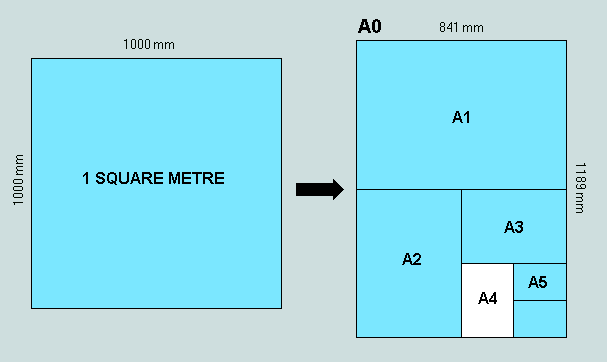
The ISO 216 A-series of paper sizes
The following is largely extracted from Markus Kuhn's web page, International Standard Paper Sizes,
Standard paper sizes like ISO A4 are today used by more than 90% of the people on this planet.
ISO 216 defines the A series of paper sizes as follows:
These features are portrayed in the following diagram:

The ISO standard paper size system covers a wide range of formats, but not all of them are widely used in practice. Among all formats, A4 is clearly the most important one for daily office use; it has a nominal area of 1/16 square meter and measures 297mm x 210mm.
Some main applications of the most popular formats can be summarized as:
History of the ISO paper formats
The practical and aesthetic advantages of the sqrt(2) aspect ratio for paper sizes were probably first noted by the physics professor Georg Christoph Lichtenberg (University of Göttingen, Germany, 1742-1799) in a letter that he wrote 1786-10-25 to Johann Beckmann. After introducing the meter measurement, the French government published 1794-11-03 the "Loi sur le timbre" (no. 2136), a law on the taxation of paper that defined several formats that correspond already exactly to the modern ISO paper sizes: "Grand registre" = ISO A2, "grand papier" = ISO B3, "moyen papier" = ISO A3, "petit papier" = ISO B4, "demi feuille" = ISO B5, "effets de commerce" = ISO 1/2 B5.
The French format series never became widely known and was quickly forgotten again. The A, B, and C series paper formats, which are based on the exact same design principles, were completely independently reinvented over a hundred years after the "Loi sur le timbre" in Germany by Dr. Walter Porstmann. They were adopted as the German standard DIN 476 in 1922 as a replacement for the vast variety of other paper formats that had been used before, in order to make paper stocking and document reproduction cheaper and more efficient.
The DIN paper formats were soon also introduced in many other countries. Porstmann's DIN paper format system finally became both an international standard (ISO 216) as well as the official United Nations document format in 1975 and it is today used in almost all countries on this planet. In 1977, a large German car manufacturer performed a study of the paper formats found in their incoming mail and concluded that out of 148 examined countries, 88 used already the A series formats then. [Source: Helbig/Hennig 1988]
The United States and Canada are today the only industrialized nations in which the ISO standard paper sizes are not yet widely used. However, practically all modern software, copying machines, and laser printers sold today in the U.S. support already A4 paper as a standard feature.
Universities in the U.S. increasingly use A4 size paper in laser printers and library copying machines, because most journals and conferences outside North America require papers to be submitted in A4 format and many journals and conference proceedings are printed in A4 format.
VJ: 2002-01-29